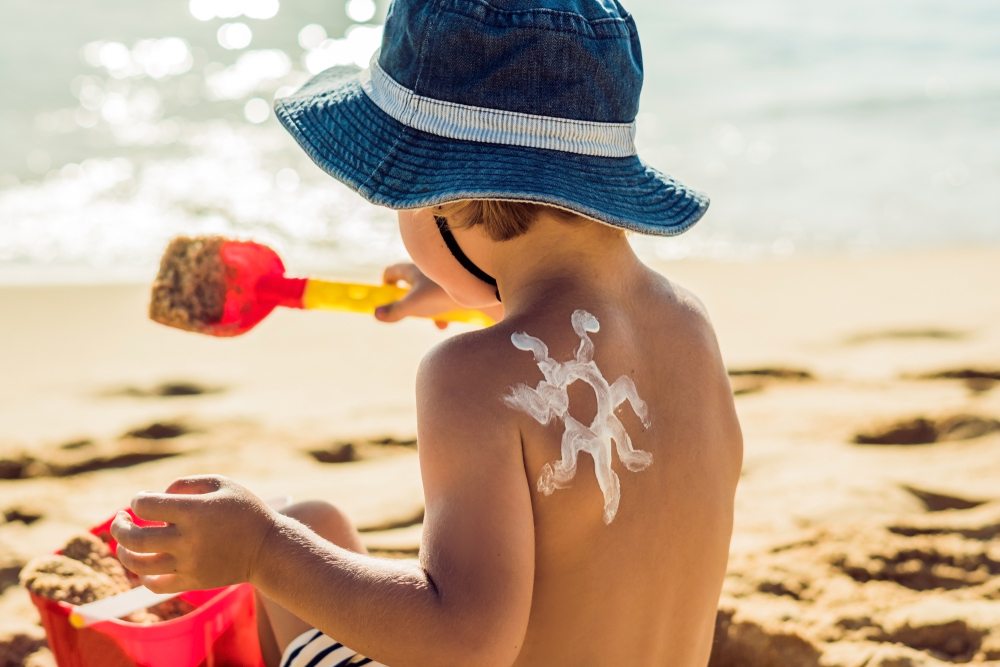
02 Aug Top Tips On Protecting Your Baby From The Sun
Babies and young children have much more sensitive skin than adults and extra precaution should be taken in exposing them to sunlight. In fact, experts estimate that a significant percentage of our exposure (between 60 – 80%) to the sun occurs by the age of 18. Most authorities agree that newborn babies should not be exposed to sunlight at all until they are at least 6 months old. Beyond that and depending on skin type, one can introduce very short periods of unprotected exposure. All other sun exposure for babies, however, must not be allowed to take place without some protection.
The following tips will help you to protect your children from the harmful effects of the sun:
- Sun protective clothing for children often comes in fun colours that a child will enjoy wearing. Look for clothing that is comfortable and easy for a child to get into. It should have long sleeves that may contain vents under the arms for cooling. Some products also contain insect repellent for even more outdoor protection.
- As with adults, keep your baby’s skin covered with light clothing, although bear in mind that UV radiation can pass through thin, open weave materials and it is possible to burn even through a shirt or blouse.
- Make sure your baby is wearing a wide-rimmed sun hat at all times. The best ones have ribbons attached so they can be tied under the chin. A sun protective hat should be made of the same tight fabric as other sun-protective clothing. It should cover the ears, with a brim that extends far enough out to provide shade and protection for the child’s nose. It should also be long enough in the back to protect his or her neck from sun exposure.
- Use a sun cream with a SPF filter of at least 15 but make sure that the sunscreen filters out both UVA and UVB radiation.
-
Kids can also wear sun protective swimsuits, which feature long sleeves and higher necks to protect their skin from the sun while in the water. You can also buy a special sun protective water shirt which can be slipped on over a swimsuit.
- Do not use alcohol-based, clear sunscreen on baby skin, because it can irritate it. Rather use a milky white sunscreen made for kids. Most natural and organic sunscreens are suitable.
- As with all sunscreens, apply liberally at least 30 minutes before exposure to the sun to give the filter time to become active. Also, remember to re-apply regularly, and especially after bathing.
- If you are in a hot climate, try and copy the locals and take a break in the heat of the day. Babies and children soon adapt to the idea of a siesta and by avoiding the heat of the day they are often happier and less irritable.
- Don’t forget your baby’s eyes! When you need sunglasses outdoors, so does your baby. Look for sunglasses that offer “100% UV Protection”. Toy sunglasses that have no UV protection built in may make exposure worse as they dilate your baby’s pupils making his or her eyes absorb more light. It is a good idea to put your own sunglasses on first to set an example before putting sunglasses on your child.
- As your children grow up, try and encourage them to assume some of the responsibility for ensuring they are safe in the sun. Give them their own bottle of sun lotion and show them how and when to use it – soon it will become a habit that will protect them for the rest of their lives.
To find out why going natural & organic with your sunscreen is better for the whole family & our planet, read on here:
The Many Merits of Organic Sunblock
10 Reasons Why a Natural Sunscreen is Important for You



Pingback:10 Reasons Why a Natural Sunscreen is Important for You - Faithful to Nature Natural and Organic Blog
Posted at 13:50h, 21 September[…] Top Tips On Protecting Your Baby From The Sun […]